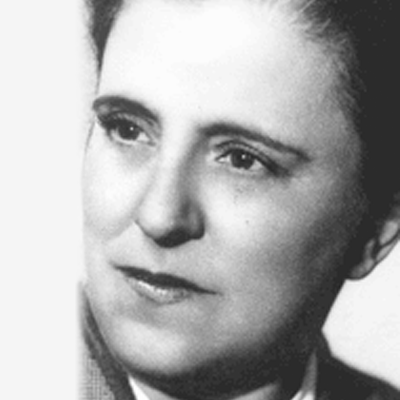Clementina Arderiu
(Nou diccionari 62 de la literatura catalana)
Barcelona, 1889-1976. Poet
Daughter of a family of silversmiths, she learned the trade and studied languages, music and piano. A keen reader, she published her first poem in 1911 and, shortly afterwards, was included in the Antologia de poetes Catalans d'avui (Anthology of Present-day Catalan Poets), published by L'Avenç (1913) and Alexandre Plana's Antologia de poetes Catalans moderns (Anthology of Modern Catalan Poets, 1914). In 1916, she published Cançons i elegies (Songs and Elegies), which brought together texts written since 1913, and she married Carles Riba, who guided her literary vocation, introducing her definitively into intellectual circles. They travelled together through Italy, Germany, France and Greece. During the Civil War their stance was clearly committed to the Republic, which meant they had to go into exile in 1939. On their return to Catalonia they played a key role in the cultural resistance.
For all Riba's importance in Clementina Arderiu's life, from the literary point of view, it was another writer who played a crucial role: Josep Carner who, among other things, as Enric Bou states, "furnished her with a particular model of composition, the song".
In the 1920s and 1930s she published L'alta llibertat (1916-1920) (High Liberty (1916-1920), which appeared in 1920, and Poemes (Poems, 1936), which brought together the two first books plus a new one, Cant i paraules (Song and Words), while also writing for numerous periodical publications, versifying texts of Rabindranath Tagore and actively participating in socio-cultural life. From very early on, as demonstrated by her inclusion in Joaquim Folguera's Les noves valors de la poesia Catalana (New Talent in Catalan Poetry, 1919), Arderiu was regarded as one of the leading lights in poetry at the time and also the best female poet and model for younger women writers since she had opened up, as Octavi Saltor says, "the way to all the most intimate, subjective and diverse effusions of feminine sensibility".
In 1938 she received the Joaquim Folguera prize with Sempre i ara (Always and Now), which was published in 1946 and expanded in the 1952 edition of Poesies completes (Complete Poetry). This was followed by És a dir (Which Is To Say, 1959), winner of the "Óssa Menor" Prize in 1958 and the "Lletra d’Or" Prize in 1960; L'esperança encara (Hope Still, 1969); and Obra poètica (Poetic Works, 1973), which brought together the entirety of a production that was closely linked with life experience –in which the fact of being a woman was crucial– and presided over by a poetics with echoes of Joan Maragall. Love, faith, happiness, the song, the female condition, pain, distress, sadness, fear and death are themes that, with more or less presence and different treatments according to the time and circumstances of writing, prevail in a poetic opus that is very well-elaborated, refined and measured in its expression of sentiments while also of extraordinary expressive power; it is a poetry that, initially unwritable in the Noucentist movement, went beyond it with the incorporation of elements of the cultured and popular Catalan traditions, of symbolism and of the avant-garde.
Copyright text © 2000 Edicions 62




